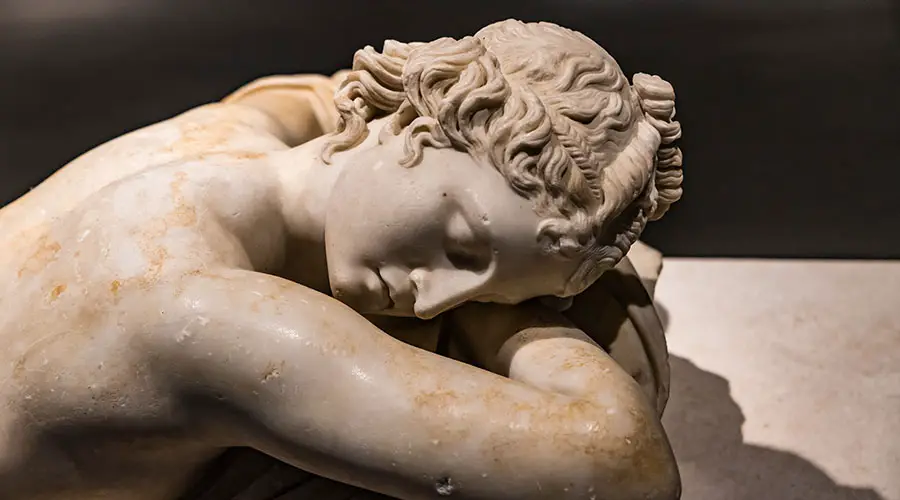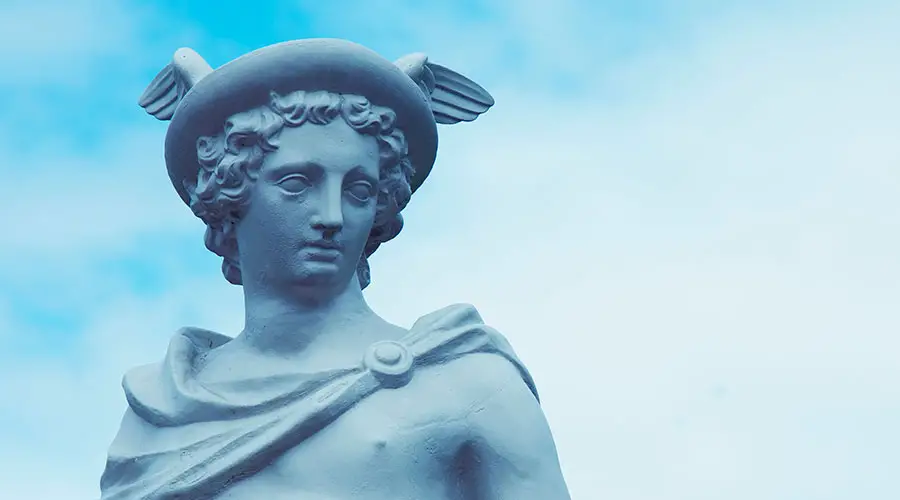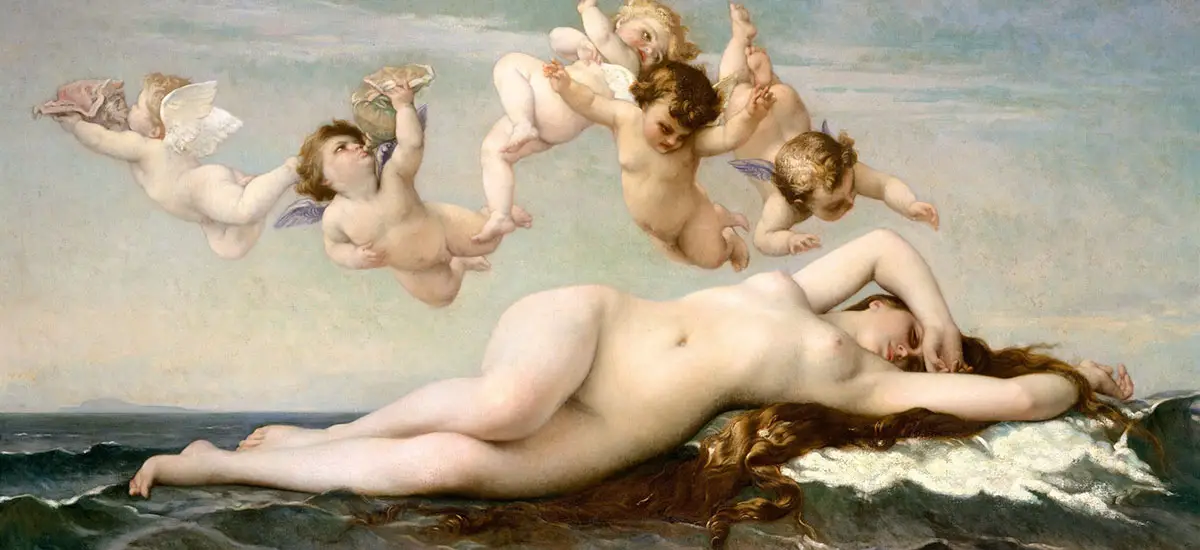Hermes and Aphrodite were two of the most attractive Greek gods, and while they were not close, they did have a child together.
Hermes and Aphrodite had one child together, named Hermaphroditus. When the child was bathing in the river, a nymph fell in love with him. She prayed that they would be merged into one being, with male and female sexual organs. Hermaphroditus became a symbol for androgyny, possessing male and female characteristics.
As the child of two powerful and influential gods, Hermaphroditus was an important figure in Greek mythology, and his story was a significant part of the mythological tradition.

The Child of Hermes and Aphrodite
In Greek mythology, the story of how Hermes and Aphrodite had a baby together is told in the myth of Hermaphroditus. According to the myth, Aphrodite was attracted to the youthful beauty and charm of Hermes, and the two of them became lovers.
The story of how Hermes seduced Aphrodite is not well documented in Greek mythology. However, it is known that both Hermes and Aphrodite were known for their charisma, wit, and beauty, so it is likely that their union was a result of mutual attraction.

In some versions of the myth, Hermes was said to have been so smitten with Aphrodite that he used his powers of wit and trickery to win her over. In other versions, Aphrodite was said to have been drawn to Hermes’ youthful charm and good looks, and the two of them became lovers as a result.
Regardless of how it happened, the union between Hermes and Aphrodite was seen as a symbol of the power of desire and the transformative nature of love. These two powerful and influential gods coming together represented the complex and powerful forces that shape the lives of all mortals.
Together, Hermes and Aphrodite had a child, named Hermaphroditus.
One day, while Hermaphroditus was bathing in a spring, the nymph Salmacis saw him and fell in love with him. She prayed to the gods to join her and Hermaphroditus together forever, and her prayer was answered. The two of them merged into one being, with both male and female characteristics.
This is how Hermaphroditus, the child of Aphrodite and Hermes, came to be. He was considered to be a symbol of androgyny and was often depicted in ancient art as possessing both male and female sexual organs.
Overall, the myth of Hermaphroditus highlights the power of desire and the transformative nature of love. As the child of two powerful and influential gods, Hermes and Aphrodite, Hermaphroditus was seen as a symbol of the complex and powerful forces that shape the lives of all mortals.

The relationship between Hermes and Aphrodite
In Greek mythology, Hermes and Aphrodite are depicted as having a complex relationship that involves both affection and conflict. While they are not considered to be close friends, their paths often cross, and they are often portrayed as interacting with one another in various myths and legends.
One example of their interaction is the myth of Aphrodite’s affair with Ares, the god of war. When Aphrodite’s husband, Hephaestus, discovered her infidelity, he set a trap for the two lovers and caught them in the act. Hermes, who was friends with both Hephaestus and Aphrodite, was called upon to act as a mediator and help resolve the situation. You can read more about the complex love triangles of the greek gods here.
Another example is the myth of the judgment of Paris, in which Hermes is depicted as one of the contestants. In this story, Paris was asked to choose the fairest goddess, and Hermes was one of the three deities who competed for his attention. Read more about Hermes here.
These are just a few examples of how Hermes and Aphrodite interacted in Greek mythology. While their relationship was not always smooth, they were both powerful and influential gods in their own right, and their paths often crossed in important and interesting ways.
Hermaphroditus the Hermaphrodite
Hermaphroditus is considered to be the child of Aphrodite, the goddess of love and beauty, and Hermes, the god of commerce and messenger of the gods. The myth of Hermaphroditus tells the story of how the child came to be a hermaphrodite, possessing both male and female characteristics.
According to the myth, Hermaphroditus was a beautiful and effeminate young man who was bathing in a spring. The nymph Salmacis saw him and became infatuated with him, and she prayed to the gods to join her and Hermaphroditus together forever. Her prayer was answered, and the two were merged into one being, with both male and female characteristics.
Hermaphroditus was considered to be a symbol of androgyny and was often depicted in ancient art as possessing both male and female sexual organs. The myth of Hermaphroditus was seen as a cautionary tale about the dangers of sexual desire and the importance of maintaining the boundaries between the sexes.
Overall, Hermaphroditus was an important figure in Greek mythology, and his story was a significant part of the mythological tradition. As the child of two powerful and influential gods, Aphrodite and Hermes, Hermaphroditus was seen as a symbol of the complex and powerful forces that shape the lives of all mortals.
The Other children of Aphrodite and Hermes
Hermaphroditus is the only child recorded as being the offspring of the union between Aphrodite, the goddess of love and beauty, and Hermes, the messenger of the gods and god of commerce. There is no mention of any other children being born from their union.
Aphrodite, the Greek goddess of love and beauty, was said to have had several children in Greek mythology. Here are some of her most famous offspring:
Eros (Cupid) – Eros was the god of love and desire, and was often depicted as a winged figure armed with a bow and arrows.
Anteros – Anteros was the god of requited love and was considered to be the counterpart of Eros.
Harmonia – Harmonia was the goddess of harmony and was said to bring balance and order to the world.
Rhodos – Rhodos was the goddess of the island of Rhodes, and was considered to be the personification of the island itself.
Aeneas – Aeneas was a legendary Trojan hero who was said to have been fathered by Aphrodite’s mortal lover, Anchises.
Hermes was said to have had several children in Greek mythology. Some of his most famous offspring include:
Pan – Pan was the god of the wild and was often depicted as a goat-legged figure with the horns and beard of a goat.
Daphnis – Daphnis was a legendary shepherd and musician who was said to have been fathered by Hermes.
Hermaphroditus – Hermaphroditus was a hermaphrodite, possessing both male and female characteristics, and was the result of a union between Hermes and Aphrodite.
Tyche – Tyche was the goddess of fortune and prosperity and was said to have been fathered by Hermes.
Autolycus – Autolycus was a legendary thief and trickster who was said to have been fathered by Hermes.
Recommended Reading
If you want to continue exploring this subject more deeply, you can see which books I recommend by clicking here.
